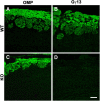Heterotrimeric G protein subunit Gγ13 is critical to olfaction
- PMID: 23637188
- PMCID: PMC3678349
- DOI: 10.1523/JNEUROSCI.5563-12.2013
Heterotrimeric G protein subunit Gγ13 is critical to olfaction
Abstract
The activation of G-protein-coupled olfactory receptors on the olfactory sensory neurons (OSNs) triggers a signaling cascade, which is mediated by a heterotrimeric G-protein consisting of α, β, and γ subunits. Although its α subunit, Gαolf, has been identified and well characterized, the identities of its β and γ subunits and their function in olfactory signal transduction, however, have not been well established yet. We, and others, have found the expression of Gγ13 in the olfactory epithelium, particularly in the cilia of the OSNs. In this study, we generated a conditional gene knock-out mouse line to specifically nullify Gγ13 expression in the olfactory marker protein-expressing OSNs. Immunohistochemical and Western blot results showed that Gγ13 subunit was indeed eliminated in the mutant mice's olfactory epithelium. Intriguingly, Gαolf, β1 subunits, Ric-8B and CEP290 proteins, were also absent in the epithelium whereas the presence of the effector enzyme adenylyl cyclase III remained largely unaltered. Electro-olfactogram studies showed that the mutant animals had greatly reduced responses to a battery of odorants including three presumable pheromones. Behavioral tests indicated that the mutant mice had a remarkably reduced ability to perform an odor-guided search task although their motivation and agility seemed normal. Our results indicate that Gαolf exclusively forms a functional heterotrimeric G-protein with Gβ1 and Gγ13 in OSNs, mediating olfactory signal transduction. The identification of the olfactory G-protein's βγ moiety has provided a novel approach to understanding the feedback regulation of olfactory signal transduction pathways as well as the control of subcellular structures of OSNs.
Figures







Similar articles
-
G protein γ subunit Gγ13 is essential for olfactory function and aggressive behavior in mice.Neuroreport. 2018 Oct 17;29(15):1333-1339. doi: 10.1097/WNR.0000000000001122. Neuroreport. 2018. PMID: 30157062 Free PMC article.
-
Conditional Deletion of Ric-8b in Olfactory Sensory Neurons Leads to Olfactory Impairment.J Neurosci. 2017 Dec 13;37(50):12202-12213. doi: 10.1523/JNEUROSCI.0943-17.2017. Epub 2017 Nov 8. J Neurosci. 2017. PMID: 29118104 Free PMC article.
-
Ric-8B interacts with G alpha olf and G gamma 13 and co-localizes with G alpha olf, G beta 1 and G gamma 13 in the cilia of olfactory sensory neurons.Mol Cell Neurosci. 2008 Jul;38(3):341-8. doi: 10.1016/j.mcn.2008.03.006. Epub 2008 Apr 1. Mol Cell Neurosci. 2008. PMID: 18462949
-
Heterotrimeric G proteins in C. elegans.WormBook. 2006 Oct 13:1-25. doi: 10.1895/wormbook.1.75.1. WormBook. 2006. PMID: 18050432 Free PMC article. Review.
-
Translating G protein subunit diversity into functional specificity.Curr Opin Cell Biol. 2004 Apr;16(2):206-9. doi: 10.1016/j.ceb.2004.02.007. Curr Opin Cell Biol. 2004. PMID: 15196565 Review.
Cited by
-
Ablation of the GNB3 gene in mice does not affect body weight, metabolism or blood pressure, but causes bradycardia.Cell Signal. 2014 Nov;26(11):2514-20. doi: 10.1016/j.cellsig.2014.07.030. Epub 2014 Aug 2. Cell Signal. 2014. PMID: 25093805 Free PMC article.
-
The cyclic AMP signaling pathway in the rodent main olfactory system.Cell Tissue Res. 2021 Jan;383(1):429-443. doi: 10.1007/s00441-020-03391-7. Epub 2021 Jan 15. Cell Tissue Res. 2021. PMID: 33447881 Review.
-
Olfactory receptor 2 in vascular macrophages drives atherosclerosis by NLRP3-dependent IL-1 production.Science. 2022 Jan 14;375(6577):214-221. doi: 10.1126/science.abg3067. Epub 2022 Jan 13. Science. 2022. PMID: 35025664 Free PMC article.
-
Transcriptome analyses of brain arteries and microvessels in male and female mice reveal prominent olfactory receptor gene and protein expression.J Cereb Blood Flow Metab. 2025 Aug 16:271678X251359753. doi: 10.1177/0271678X251359753. Online ahead of print. J Cereb Blood Flow Metab. 2025. PMID: 40817784 Free PMC article.
-
G-protein-coupled receptor signaling and neural tube closure defects.Birth Defects Res. 2017 Jan 30;109(2):129-139. doi: 10.1002/bdra.23567. Birth Defects Res. 2017. PMID: 27731925 Free PMC article. Review.
References
Publication types
MeSH terms
Substances
Grants and funding
LinkOut - more resources
Full Text Sources
Other Literature Sources
Molecular Biology Databases
